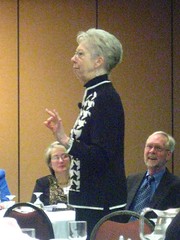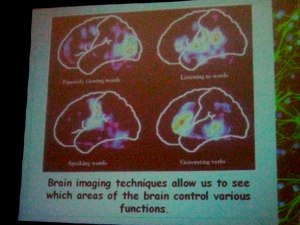Live Blogged, so please excuse typos and awkward wording.
 Today, I’m presenting with brain research guru, Patricia Wolfe for a school boards staff development day — dubbed Brainstorm. Pat talks this morning about what’s happening inside the brains of our students. I’ll be talking this afternoon about what’s happening outside their brains.
Today, I’m presenting with brain research guru, Patricia Wolfe for a school boards staff development day — dubbed Brainstorm. Pat talks this morning about what’s happening inside the brains of our students. I’ll be talking this afternoon about what’s happening outside their brains.
I enjoyed a fascinating breakfast with Pat, and hope upon hope that I’ve got the energy and curiosity twenty hears from now.
Powers on high have written prescriptions for our students learning, and they are not working!
She says that she remembers who sat behind her when she took high school chemistry and that is all — and she made an “A.” We have the false assumption that if kids can give back what we’ve taught at the prescribed time, they’ve learned. Her very school-successful son, who is now 44, recently told her that he had a very high HTI — High Trivia Index. B.F. Skinner actually worked with pigeons. This is where the learning theories that I was schooled under, and that I was taught to school, comes from.
We are moving from a behaviorist mode of education to a biological mode of education.
This doesn’t mean that teachers have not done a good job. Good teachers are intuitive, but the problem with that is that you can teach it to other teachers.
I don’t care what test scores are!
Is teaching going to have to change. On the whole we are in a very inarticulate profession. We need to move from being a folklore profession to being a scientific profession (cringing a bit here, but listening).
 The brain runs on glucose that is processed in the liver and carried by the cardiovascular system. It’s why when she hears about schools that are cutting back on recess and PE for the sake of academics, then they’re shooting themselves in the heart and the brain.
The brain runs on glucose that is processed in the liver and carried by the cardiovascular system. It’s why when she hears about schools that are cutting back on recess and PE for the sake of academics, then they’re shooting themselves in the heart and the brain.
She’s now showing MRI reading of brains when the subject is passively viewing words, listening to words, speaking words, generating verbs. Fascinating!
Every one of the 100 billion brain cells we have have about 6,000 dendrites.
Learning is the act of making and strengthening connections.
You don’t grow brain cells. What grows are dendrites, and “Dittos don’t grow dendrites!”
The two most useless questions:
|
The brain is the only organ in the body that changes as a result of its experience. If someone is born blind, then the parts of the brain used for vision, get aligned to auditory and tactile. Researchers found that if people are blindfolded for days, brain cells that were processing visual information starts to handles auditory information. I’m paraphrasing a good bit here, so I hope I’m getting it right.
The brain seeks meaningful patterns
We have our brains to survive, so it is not good at working information that has no meaning to their experience. Yet this is what and how we teach.
Pat Wolfe learned to fly during her second year of teaching. She thought, if she’d been taught to fly the same way she was taght to teach, she would have learned the philosophy, pshychology, and history of flying, and all she’d be able to do is taxi her plane — which is what most first year teachers are doing.
Talking about History Alive, a very brain compatible (her term) way of learning history. I’m not aware of History Alive, though I found a paper at ERIC (History Alive! Six Powerful Constructivist Strategies, that is not downloadable. If you have anything to add about History Alive, please share in the comments.
Two kinds of memory:
- Procedural Memory: Skills and habits that have been practiced to a point where they are automatic and unconscious.
- Declarative Memory: Our general knowledge and our live experiences that we can declare or recall consciously.
We should use rote rehearsal to learn things that are appropriate for procedural memory. But we tend to use rote rehearsal to learn things that are more appropriate for declarative memory, but it’s not the best way to learn what’s to be declared.
Wow, she just got us to say, “tot tot,” but tapping into our procedural memory.
The human brain loves anything that can but put to rhyme rhythm, or rap.
Technorati Tags: warlick education brainresearch patwolfe asba arkansas

Teaching is the art of making and strengthening connections!
David,
I believe that reflecting on those connections is also an important part of learning.
Looking back at my K-16 experience, all I see is a timeline with a big blur of facts. I don’t think I had the ability to reflect on these facts. Maybe I was too worried about socializing and having fun. Most of my real learning has occurred post college. This goes to show you that learning is an active activity. I could have chosen not to learn after college. Instead, I seek knowledge every day and read the writing of people that make me think.
I can see this when I watch students or anyone who is passively learning facts instead of being involved in researching the information to determine their own conclusions. The brain needs activity. That’s why children love interactive games, texting, and being part of a constructivist classroom experience.
Just imagine what we’ve done to their brains with all the testing and accountability stuff. It makes me sad to know that we have taken almost a whole generation of children and taught them how to not think, how to follow directions, how to fill in bubbles on a test. Why? The world we prepared them for to use these skills isn’t here anymore.
I just think about the multiple choice tests I took in school. The tests on specific dates where there was no relevance to how these dates related to anything else. Good teachers go beyond the tests but there isn’t enough time to cover all of these miniscule trivial items. There has to be a connection – a real world connection. If students take the initiative to find the connection and then share it with others, they’ll be able to use this information effectively.
Thanks for sharing this, David – though I just asked for questions while teaching my graduate seminar… (smile) Has she elaborated or described what a brain-responsive k-12 teaching practice would look LIk
If those are useless questions, would she advocate that better questions would be like “What is the connection here between…” or “How does this relate to…”?
As far as the test score thing, I don’t care about them either. It is an apples to oranges comparison that I am sure you have talked about before. I am more concerned that my kids can apply what they learn to a new situation than I am that they can parrot back facts and definitions.
David,
Here’s what I found for History Alive! Going to play with it a bit, but it seems like this would be more of a “learn what you have an interest in knowing” kind of approach-always more motivating:) http://www.tutorial.historyalive.com/
I have to admit that I didn’t learn alot about history in school…I learned it when I had to teach it:)
Sorry, posted too soon- that link is just a small part of this whole big “thing” you can purchase…hmmm not so sure about it. Anyone out there tried it?
I adore History Alive! 🙂
I was introduced to it in college, when they gave us their overview book that explains how it works and gives you ideas for creating their kinds of lessons. It is a big expensive thing you can purchase if you want their lessons for different things, but it’s basically an entire year’s worth of lessons for the topic if you follow their curriculum. I’ve been taking bits and pieces and occasionally whole lessons, since I’m stuck with my curriculum. (We have it because it got bought for our school years ago, so it’s the outdated binders with slides rather than CDs. Can’t get enough money to rebuy it.)
Anyway, even if you’re not up for buying their whole thing, the History Alive notebook idea and different lesson types are worth looking at in terms of making social studies more interactive/problem-solving oriented. Take a lot at their sample lessons to get an idea of what they do if you’re curious: http://www.teachtci.com/forum/
Hello!
Muscles change as a result of experience.
So does your skin.
Actually, our whole body is very adaptive… thank goodness for that…. I guess remembering that we all started off as a zygote with that full one set of chromosomes brings home that point.
But good teachers have always taught that the brain is like a muscle and that you have to work hard to make it work better? To label children as “smart” (implying that if you weren’t smart, you would never be) is …
hm..=)
Vejraska,
History Alive seems to involve creating experiences in the classroom to help students understand events and concepts in history, rather than just teaching it to them. For instance, Wolfe described a teacher who helped her students understand the industrial revolution be pretending to make the class a factory, and presenting suggestion situations that affected the students directly. Then she asked questions that had the students probe their reactions, as a result concluding concepts that are part of the curriculum.
I think that a lot of history teachers (and other subjects) do this already. I often did, because it made sense to me. It’s like Wolfe said, good teachers are already doing these things intuitively.
Thanks for the clarification, and it’s true I am sure that lots of great teachers are already doing stuff like that. ie: I teach my 3rd graders government/constitution by turning my classroom in to a government system and having my kids write their own constitution….here’s my deal though…it would be great to find a program like this that has a ready-made framework for teaching the concepts, but then how does that fit with the idea of student directed learning…what if I save all my pennies to get this program, and then when I start using it, the kids go in a totally different direction- I think I’ll save my pennies for something else.